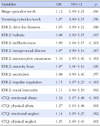Abstract
Purpose
The purpose of the study was to investigate the factors that affect multi-impulsivity in women patients with eating disorders.
Methods
The participants in the study were 170 women patients with eating disorders who visited "M" clinic for eating disorders. Data were collected from January 2010 to February 2011 through semi-structured interviews and self-report using the Revised Diagnostic Interview for Borderlines, Eating Disorders Inventory-2, and The Childhood Trauma Questionnaire. Data were analyzed using χ2-test, t-test, and multiple logistic regression.
Results
The multi-impulsivity group accounted for 56.5% of the patients (binge eating 90.6%, alcohol abuse 43.5%, substance abuse 37.1%, sexual promiscuity 4.7%, suicidal attempts 38.8%, and self-mutilation 58.8%), and they showed higher scores on childhood trauma and eating psychopathology than a comparison group. Significant predictors for multi-impulsivity were emotional abuse, social insecurity, interoceptive awareness, and interpersonal distrust.
Figures and Tables
Table 1
Demographic and Clinical Characteristics by Multi-impulsivity (N=170)

MI=multi-impulsive group; BMI=body mass index; AN-R=anorexia nervosa restricting type; AN-BP=anorexia nervosa bulimic binge eating/purging type; BP-P=bulimia nervosa purging type; BP-NP=bulimia nervosa non-purging type; EDNOS=eating disorders not otherwise specified.
†Two or fewer impulsive behavior.
‡Fisher's exact test.
References
1. Agras W, Crow S, Halmi K, Mitchell J, Wilson G, Kraemer H. Outcome predictors for the cognitive behavior treatment of bulimia nervosa: Data from a multisite study. Am J Psychiatry. 2000. 157:1302–1308.

2. Bernstein DP, Fink L. Childhood trauma quesiotnnaire: A retrospective self-report. Korean translation version. 1998. San Antonio, TX: The Psychological Corporation;.

3. Choi YK. Borderline psychopathology and risk factors for self-destructive behavior. 2006. Seoul: Korea University;Unpublished doctoral dissertation.
4. Corstorphine E, Waller G, Lawson R, Ganis C. Trauma and multi-impulsivity in the eating disorders. Eat Behav. 2007. 8:23–30.
5. Diehl M, Coyle N, Labouvie-Vief G. Age and sex differences in strategies of coping and defense across the life span. Psychol Aging. 1996. 11:127–139.
6. Fairburn CG, Cooper Z, Shafran R. Cognitive behaviour therapy for eating disorders: A 'transdiagnostic' theory and treatment. Behav Res Ther. 2003. 41:509–528.
7. Favaro A, Zanetti T, Tenconi E, Degortes D, Ronzan A, Veronese A, et al. The relationship between temperament and impulsive behaviors in eating disordered subjects. Eat Disord. 2005. 13:61–70.

8. Fichter M, Quadflieg N, Rief W. Course of multi-impulsive bulimia. Psychol Med. 1994. 24:591–604.

11. Kong SS. Impact of eating psychopathology, obsessive-compulsion and depression on self-harm behavior in patients with eating disorders. J Korean Acad Nurs. 2009. 39:459–468.

12. Kong SS. Factors associated with alcohol problem in patients with eating disorders. J Korean Acad Psychiatr Ment Health Nurs. 2011. 20:208–218.

13. Kong SS, Bernstein K. Childhood trauma as a predictor of eating psychopathology and its mediating variables in patients with eating disorders. J Clin Nurs. 2009. 18:1897–1907.

14. Kong SS, Lee JH, Shin MY. Impact of childhood trauma on self-harm behavior in patients with eating disorders and the mediating effect of parental conflict. J Korean Acad Psychiatr Ment Health Nurs. 2009. 18:31–40.

15. Lacey JH. Self-damaging and addictive behaviour in bulimia nervosa: A catchment area study. Br J Psychiatry. 1993. 163:190–194.

16. Lacey JH, Read T. Multi-impulsive bulimia: Description of an inpatient eclectic treatment programme and a pilot follow-up study of its efficacy. Eat Disord Rev. 1993. 1:22–31.

17. Lyle RM. Translation of Eating Disorders Inventory II-Korean. 1996. Odessa, FL: Psychological Assessment Resources.

18. Mateer CA. Executive function disorders: Rehabilitation challenges and strategies. Semin Clin Neuropsychiatry. 1999. 4:50–59.

19. Matsunaga H, Kiriike N, Iwasaki Y, Miyata A, Matsui T, Nagata T, et al. Multi-impulsivity among bulimic patients in Japan. Int J Eat Disord. 2000. 27:348–352.

20. Myers TC, Wonderlich SA, Crosby R, Mitchell JE, Steffen KJ, Smyth J, et al. Is multi-impulsive bulimia a distinct type of bulimia nervosa: Psychopathology and EMA findings. Int J Eat Disord. 2006. 39:655–661.

21. Nagata T, Kawarada Y, Kiriike N, Iketani T. Multi-impulsivity of Japanese patients with eating disorders: Primary and secondary impulsivity. Psychiatry Res. 2000. 94:239–250.

22. Nagata T, Kawarada Y, Ohshima J, Iketani T, Kiriike N. Drug use disorders in Japanese eating disorder patients. Psychiatry Res. 2002. 109:181–191.

23. Rodriguez M, Perez V, Garcia Y. Impact of traumatic experiences and violent acts upon response to treatment of a sample of Colombian women with eating disorders. Int J Eat Disord. 2005. 37:299–306.

24. Scott LN, Levy KN, Pincus AL. Adult attachment, personality traits, and borderline personality disorder features in young adults. J Pers Disord. 2009. 23:258–280.

25. Waxman SE. A systematic review of impulsivity in eating disorders. Eur Eat Disord Rev. 2009. 17:408–425.
26. Westen D, Harnden-Fischer J. Personality profiles in eating disorders: Rethinking the distinction between axis I and axis II. Am J Psychiatry. 2001. 158:547–562.
27. Wiederman MW, Pryor T. Substance use and impulsive behaviors among adolescents with eating disorders. Addict Behav. 1996. 21:269–272.

28. Winchel RM, Stanley M. Self-injurious behavior: A review of the behaviour and biology of self-mutilation. Am J Psychiatry. 1991. 148:306–317.





 PDF
PDF ePub
ePub Citation
Citation Print
Print






 XML Download
XML Download